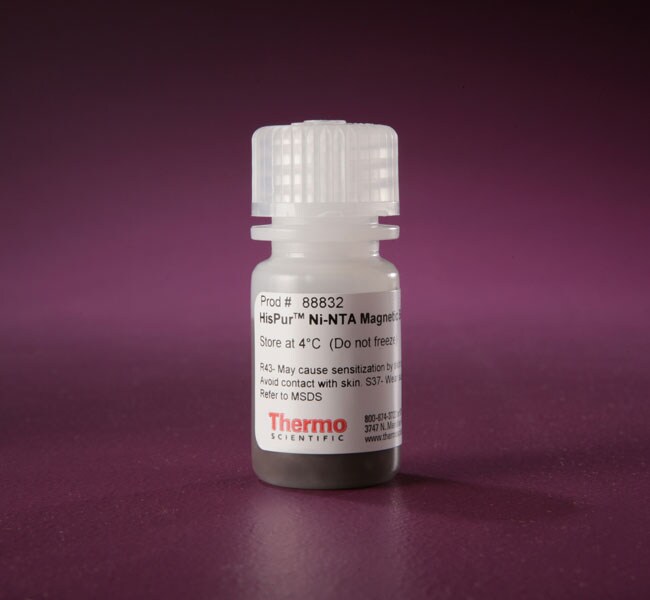Search Thermo Fisher Scientific

HisPur™ Ni-NTA magnetische Beads
| Katalognummer | Menge |
|---|---|
| 88832 | 10 ml |
| 88831 | 2mL |
Merkmale von HisPur Ni-NTA Magnetbeads:
• Hohe Kapazität — Gleiche oder höhere Bindungskapazität gegenüber Ni-NTA Magnetbeads anderer Hersteller
• Geringe unspezifische Bindung — Die Bead-Oberfläche ist vorblockiert und das Protokoll bietet optimierte Puffer für die Aufreinigung
• Schnell — Protokoll ist in 1 Stunde abgeschlossen
• Skalierbar — Verarbeitung von Proben vom Mikroliter- bis zum Milliliterbereich
•Vielseitig — Proteinreinigung unter nativen oder denaturierenden Bedingungen
• Reagenz-kompatibel — Kann mit gängigen Zelllysereagenzien und einer Vielzahl von Pufferadditiven verwendet werden
• Mehrere Formate — Die Proteinbindung an die Beads und die nachgeschalteten Anwendungen können sowohl manuell als auch mit automatisierten Plattformen (z. B. Thermo Scientific KingFisher Geräten) durchgeführt werden
Die blockierte Magnetbead-Oberfläche wird mit der Nitrilotriessigsäure(NTA)-Chelatgruppe derivatisiert und mit zweiwertigen Nickelionen (Ni2+) beladen. Die immobilisierten Metallaffinitätschromatographie(IMAC)-Beads bieten eine hohe Bindungskapazität mit einem sehr niedrigen Hintergrund. Die HisPur Ni-NTA Magnetbeads können sowohl manuell mit einem Magnetstativ als auch für hohe Durchsätze mit automatisierten Plattformen wie den Thermo Scientific KingFisher Geräten verwendet werden.
HisPur Ni-NTA Magnetbeads werden für die Affinitätsaufreinigung kleiner Mengen sowie für das Screening mit hohem Durchsatz rekombinanter His-markierter Proteine verwendet. Die Polyhistidin-Markierung ist die häufigste Affinitätsmarkierung. Sie besteht in der Regel aus sechs aufeinanderfolgenden Histidinresten (6xHis). Diese markierten Proteine werden in verschiedenen Systemen, vor allem in Bakterien, überexprimiert und aus Zelllysaten wie jenen, die mit B-PER Bacterial Protein Extraction Reagents hergestellt werden, aufgereinigt. Die Aufreinigung His-markierter Proteine erfolgt mittels eines mit Nickel beladenen NTA-Chelats, das sich koordinativ an die Histidin-Seitenketten anlagert. Das NTA-Chelat umfasst vier Metall-Bindungsstellen, was ein geringes Auslaugen der Metallionen und eine hohe Bindungskapazität möglich macht. Das Protokoll für HisPur Ni-NTA Magnetic Beads wurde dahingehend optimiert, eine hohe Reinheit des isolierten His-markierten Proteins zu ermöglichen. Die Leistung ist genau so gut wie oder besser als die von Ni-NTA Magnetbeads anderer Hersteller.
Abbildungen


Kunden, die diesen Artikel ansahen, interessierten sich auch für
Dokumente und Downloads
Zertifikate
Sicherheitsdatenblätter
Häufig gestellte Fragen (FAQ)
Both systems are qualified by purifying 2 mg of myoglobin protein on a column and performing a Bradford assay. Protein recovery must be 75% or higher.
Find additional tips, troubleshooting help, and resources within our Protein Purification and Isolation Support Center.
Nickel has a higher affinity for histidines than does cobalt. It binds multiple histidines more tightly than cobalt, and requires more stringent conditions than is necessary for cobalt. The lower affinity of cobalt for multiple histidines typically results in less nonspecific binding of histidine-rich proteins that lack a his-tag compared to nickel resins.
HisPur Ni-NTA resin has a high capacity of up to 60 mg of 6xHis-tagged protein per milliliter. It is a versatile resin that can work under both native and denaturing conditions, and can also be used with a variety of lysis reagents and buffer additives.
HisPur Cobalt resin utilizes proprietary tetradentate chelating resin charged with cobalt. This system recovers highly purified protein with lower imidazole concentrations and has low metal leeching properties.
Find additional tips, troubleshooting help, and resources within our Protein Purification and Isolation Support Center.